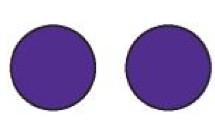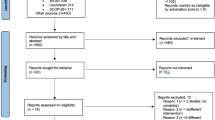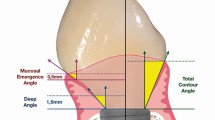Abstract
Objective
To analyze the clinical outcomes of implant-supported prostheses and tooth-supported fixed prostheses, fabricated from digital and conventional impression.
Materials and methods
The literature search was carried out on two electronic databases (PubMed and Cochrane Library). Randomized controlled trials (RCT) published from January 2011 to September 2022 were included. The bias risk was evaluated using Cochrane Risk of Bias Tool 2.0. Further screening was done for meta-analysis according to modified Newcastle-Ottawa scoring criteria. Forest plot was generated using a statistical method of inverse variance of random effect with 95% confidence interval.
Results
A total of 8 randomized controlled trials were included for systematic review out of which four studies were based on tooth-supported fixed prosthesis and remaining four were based on implant-supported prosthesis. Further screening was conducted and three studies were eligible for meta-analysis. Tooth-supported fixed prosthesis fabricated from digital impression showed no significant difference in the marginal fit in any region measured, except for occlusal region where conventional impression showed more favorable marginal fit. Implant-supported prosthesis fabricated from digital impression showed survival rates ranging from 97.3 to 100% and there was no statistically significant difference in marginal bone loss (p = 0.14).
Conclusion
Implant-supported prostheses fabricated from digital and conventional impressions show no significant differences in their clinical outcomes. Tooth-supported fixed prostheses fabricated from digital impression have shown favorable findings in terms of marginal fit. Despite that, there is still lack of clinical trials with larger sample size and longer follow-up periods. Future studies that fulfill these two criteria are deemed necessary.
This is a preview of subscription content, access via your institution
Access options
Subscribe to this journal
Receive 4 print issues and online access
$259.00 per year
only $64.75 per issue
Buy this article
- Purchase on Springer Link
- Instant access to full article PDF
Prices may be subject to local taxes which are calculated during checkout



Similar content being viewed by others
References
Ruse N, Sadoun M. Resin-composite blocks for dental CAD/CAM applications. J Dent Res. 2014;93:1232–4.
Spitznagel F, Boldt J, Gierthmuehlen P. CAD/CAM ceramic restorative materials for natural teeth. J Dent Res. 2018;97:1082–91.
Tsirogiannis P, Reissmann DR, Heydecke G. Evaluation of the marginal fit of single-unit, complete-coverage ceramic restorations fabricated after digital and conventional impressions: a systematic review and meta-analysis. J Prosthet Dent. 2016;116:328–35.
Joda T, Brägger U. Digital vs. conventional implant prosthetic workflows: a cost/time analysis. Clin Oral Implants Res. 2014;26:1430–5.
Blatz MB, Conejo J. The current state of chairside digital dentistry and materials. Dent Clin North Am. 2019;63:175–97.
Joda T, Brägger U. Patient-centered outcomes comparing digital and conventional implant impression procedures: a randomized crossover trial. Clin Oral Implants Res. 2016;27:185–9.
Schepke U, Meijer H, Kerdijk W, Cune M. Digital versus analog complete-arch impressions for single-unit premolar implant crowns: operating time and patient preference. J Prosthet Dent. 2015;114:403–6.
Wismeijer D, Mans R, van Genuchten M, Reijers H. Patients’ preferences when comparing analogue implant impressions using a polyether impression material versus digital impressions (Intraoral Scan) of dental implants. Clin Oral Implants Res. 2013;25:1113–8.
Yuzbasioglu E, Kurt H, Turunc R, Bilir H. Comparison of digital and conventional impression techniques: evaluation of patients’ perception, treatment comfort, effectiveness and clinical outcomes. BMC Oral Health. 2014;14:10.
Higgins JPT, Thomas J, Chandler J, Cumpston M, Li T, Page MJ, et al. (editors). Cochrane Handbook for Systematic Reviews of Interventions version 6.2 (updated February 2021). Cochrane, 2021. Available from www.training.cochrane.org/handbook.
Gjelvold B, Chrcanovic B, Korduner E, Collin-Bagewitz I, Kisch J. Intraoral digital impression technique compared to conventional impression technique. a randomized clinical trial. J Prosthodont. 2016;25:282–7.
Zeltner M, Sailer I, Mühlemann S, Özcan M, Hämmerle C, Benic G. Randomized controlled within-subject evaluation of digital and conventional workflows for the fabrication of lithium disilicate single crowns. Part III: marginal and internal fit. J Prosthet Dent. 2017;117:354–62.
Benic G, Sailer I, Zeltner M, Gütermann J, Özcan M, Mühlemann S. Randomized controlled clinical trial of digital and conventional workflows for the fabrication of zirconia-ceramic fixed partial dentures. Part III: marginal and internal fit. J Prosthet Dent. 2019;121:426–31.
Ahrberg D, Lauer HC, Ahrberg M, Weigl P. Evaluation of fit and efficiency of CAD/CAM fabricated all-ceramic restorations based on direct and indirect digitalization: a double-blinded, randomized clinical trial. Clin Oral Investig. 2016;20:291–300.
Mühlemann S, Lakha T, Jung R, Hämmerle C, Benic G. Prosthetic outcomes and clinical performance of CAD‐CAM monolithic zirconia versus porcelain‐fused‐to‐metal implant crowns in the molar region: 1‐year results of a RCT. Clin Oral Implants Res. 2020;31:856–64.
Mangano F, Veronesi G. Digital versus analog procedures for the prosthetic restoration of single implants: a randomized controlled trial with 1 year of follow-up. Biomed Res Int. 2018;2018:1–20.
Joda T, Ferrari M, Bragger U, Zitzmann NU. Patient reported outcome measures (PROMs) of posterior single-implant crowns using digital workflows: a randomized controlled trial with a three-year follow-up. Clin Oral Implants Res. 2018;29:954–61.
Cappare P, Sannino G, Minoli M, Montemezzi P, Ferrini F. Conventional versus digital impressions for full arch screw-retained maxillary rehabilitations: a randomized clinical trial. Int J Environ Res Public Health. 2019;16:829.
Al-Haj Husain N, Özcan M, Molinero-Mourelle P, Joda T. Clinical performance of partial and full-coverage fixed dental restorations fabricated from hybrid polymer and ceramic CAD/CAM materials: a systematic review and meta-analysis. J Clin Med. 2020;9:2107.
Bandiaky ON, Le Bars P, Gaudin A, Hardouin JB, Cheraud-Carpentier M, Mbodj EB, et al. Comparative assessment of complete-coverage, fixed tooth-supported prostheses fabricated from digital scans or conventional impressions: a systematic review and meta-analysis. J Prosthet Dent. 2022;127:71–9.
Nagarkar SR, Perdigão J, Seong W-J, Theis-Mahon N. Digital versus conventional impressions for full-coverage restorations. J Am Dent Assoc. 2018;149:139–47.
Patzelt SB, Spies BC, Kohal RJ. CAD/CAM-fabricated implant-supported restorations: a systematic review. Clin Oral Implants Res. 2015;26:77–85.
Cheah C, Lim C, Ma S. The dentist will scan you now: the next generation of digital‐savvy graduates. Eur J Dent Educ. 2020;25:232–7.
Peñarrocha-Diago M, Balaguer-Martí JC, Peñarrocha-Oltra D, Balaguer-Martínez JF, Peñarrocha-Diago M, Agustín-Panadero R. A combined digital and stereophotogrammetric technique for rehabilitation with immediate loading of complete-arch, implant-supported prostheses: a randomized controlled pilot clinical trial. J Prosthet Dent. 2017;118:596–603.
Ferrini F, Capparé P, Vinci R, Gherlone EF, Sannino G. Digital versus traditional workflow for posterior maxillary rehabilitations supported by one straight and one tilted implant: a 3-year prospective comparative study. Biomed Res Int. 2018;2018:1–7.
Joda T, Ferrari M, Gallucci GO, Wittneben J-G, Brägger U. Digital technology in fixed implant prosthodontics. Periodontol 2000. 2016;73:178–92.
Joda T, Zarone F, Zitzmann NU, Ferrari M. The functional implant prosthodontic score (FIPS): assessment of reproducibility and observer variability. Clin Oral Investig. 2018;22:2319–24.
Funding
The study was supported by International Medical University, Kuala Lumpur, Malaysia, under the student research grant.
Author information
Authors and Affiliations
Contributions
This study was designed, directed and coordinated by NS, SK, NSM, NJ and PP. NS and SK provided the conceptual and technical guidance for this research. Electronic search strategy was conducted by NSM, and the results of literature search were screened by SK and NJ following the inclusion and exclusion criteria. Data extraction for the systematic review was done by NSM and cross checked by SK, NJ and PP. For meta-analysis, scoring criteria was planned by NJ and the meta-analysis was conducted by NSM. NSM, NS, SK, NJ contributed to the interpretation of results. Manuscript writing was conducted by NSM with additional input and feedback from NS, SK, NJ and PP. All authors discussed the results and commented on the manuscript.
Corresponding author
Ethics declarations
Competing interests
The authors declare no competing interests.
Additional information
Publisher’s note Springer Nature remains neutral with regard to jurisdictional claims in published maps and institutional affiliations.
Rights and permissions
Springer Nature or its licensor (e.g. a society or other partner) holds exclusive rights to this article under a publishing agreement with the author(s) or other rightsholder(s); author self-archiving of the accepted manuscript version of this article is solely governed by the terms of such publishing agreement and applicable law.
About this article
Cite this article
Mahat, N.S., Shetty, N.Y., Kohli, S. et al. Clinical outcomes of implant-supported and tooth-supported fixed prostheses fabricated from digital versus analogue impression: a systematic review and meta-analysis. Evid Based Dent 24, 142 (2023). https://doi.org/10.1038/s41432-023-00904-5
Received:
Accepted:
Published:
Issue Date:
DOI: https://doi.org/10.1038/s41432-023-00904-5



